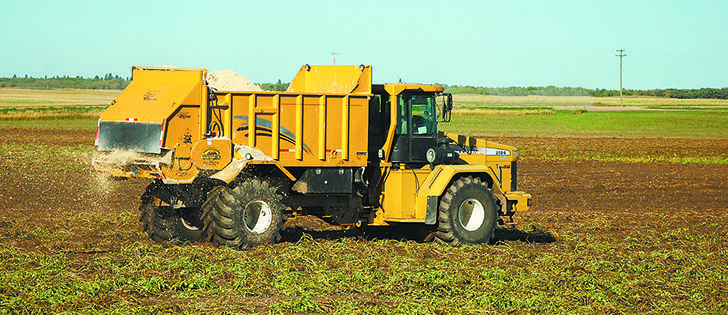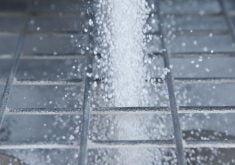Potatoes are typically grown under irrigation, on sandy soil and with plenty of commercial fertilizer. It’s the perfect setup for severe acidity and a perfect scenario for lime treatment.
The three main factors contributing to severe acidity are irrigation, high fertilizer rates and soil with a low pH to begin with, according to independent agronomist Trevor Thornton of Crop Care Consulting in Manitoba.
Thornton has been working with Manitoba potato growers for 10 years. In that time, he and his staff of four agronomists have fine tuned their expertise in using lime to up-grade severely acidic soils.
Read Also

Volatile temperatures expected for this winter
DTN is forecasting a lot of temperature variability in the Canadian Prairies this winter. Precipitation should be close to average.
“By severely acidic, I mean soils which had a pH of 4.5 when we started working with them 10 years ago. I’m guessing they were 5.0 to 5.5 pH initially,” says Thornton.
Many fields started with acidic soils because of the way the parent material was laid down. There was no human fault.
However, in Thornton’s opinion, growing crops with a high nitrogen demand made the situation worse.
Thornton said that in dry conditions, a low pH like 4.5 allows hydrogen to build up in the soil, where it acts like a torch on plant roots. Nutrients might be right next to the roots, but the roots can’t access them. The situation is only slightly better in an irrigated field.
Potatoes are a high-value, high-input crop, which is why Thornton carries out an intensive grid sampling program with his clients. On potato land, he uses a one acre or two acre grid system. On all other crops, he uses a five acre grid.
“With so much cash on the line, it’s important that our variable rate prescription maps are accurate. I’ve got fields where the highest pH and lowest pH are right next to each other. We find things that zone sampling would never pick up. You need to know those things if you plan to apply lime.
“You must put lime down with a variable rate prescription map. If you put too much lime where it’s not needed, you just create another problem for yourself on the other side of the pH scale.”
Thornton emphasized that if you don’t use enough lime, you’re missing some cash opportunities, not only with the potatoes but with other crops in the rotation.
A typical rotation employs fall rye or spring wheat after potatoes and then a canola crop. Some growers have started putting soybeans, edible beans and corn into the mix, although corn may not be the best option.
“Corn demands a lot of nitrogen fertilizer and that’s not something you want to do if you’re already fighting acidic soils.”
After a decade of liming low pH soils, how do the numbers look?
“Grain yields in our clients’ fields have increased 15 to 20 bushels per acre where we’ve applied lime treatments with a variable rate system.
“Of course, grain is just part of the rotation. Potato is the main crop. The lime treatment has increased the potato yield by as much as 80 hundred weight per acre. Plus, internal quality defects have dropped significantly.”
But none of this good news comes without a price. Although Thornton only applies lime to areas in a field where it will have a significant economic impact, the high end of that scale might be as much as two tonnes of lime per acre.
Thornton says he cannot quote exact prices because of all the variables involved in liming a specific field. However, he can give ballpark figures.
“If you have some areas in a field that require the maximum rate of two tonnes per acre, you can figure $30 to $40 per tonne, depending on delivery distance and things like that.
“So, yes, that’s $60 to $80 per acre. But keep in mind that not every field is at the high rate and few fields require full coverage. That’s why I insist on variable rate.
“And then consider that your treated acres might give you 15 or 20 bushels more wheat and 80 hundred weight more potatoes.”
A review of the Internet shows dozens of different types and sources of agricultural lime.
Municipal water treatment plants utilize lime as one of the agents in purifying potable water for towns and cities. This is the source Thornton uses for field lime.
The slime-like lime is trucked to the field in a regular dump box truck and applied through an Ag Chem twin spinner floater truck designed in the U.S. specifically for this material.
“The stuff we get is 50 percent moisture, so it’s not really sludge, but it’s not really granular either. Standard ag grade lime is 60 percent through a 100 mesh screen. It takes about three years to react with the soil.
“The stuff we get is 100 percent through a 100 mesh screen. It’s an incredibly fine grind. That also means it’s soil reactive immediately, so you have to be careful not to apply too much at a time. That’s why we have to use variable rate.
“It’s a challenge to spread through a Valmar or a regular floater. We tried manure spreaders, but it’s too difficult to control the rate. The Ag Chem spin spreader has variable rate, and it’s designed for this material.”
Contact Trevor Thornton at 204-476-0014.
















